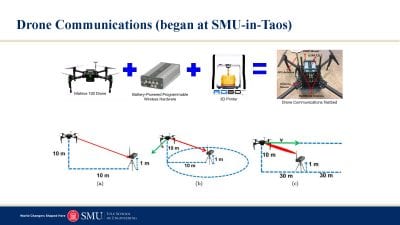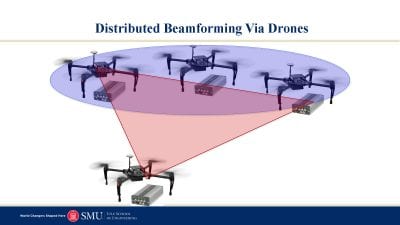Sea Monsters Unearthed: Life in Angola’s Ancient Seas opens Nov. 9 at National Museum of Natural History
DALLAS (SMU October 15, 2018) – Once the exhibit opens, “Sea Monsters Unearthed: Life in Angola’s Ancient Seas” will allow visitors to visually dive into the cool waters off the coast of West Africa as they existed millions of years ago when the continents of Africa and South America were drifting apart. It’s a unique opportunity to examine fossils of ancient marine reptiles and learn about the forces that continue to mold life both in out of the ocean.
But the back story is just as fascinating: SMU Emeritus Professor of Paleontology Louis Jacobs and his SMU colleague Michael Polcyn forged a partnership with collaborators in Angola, Portugal and the Netherlands to explore and excavate Angola’s rich fossil history, while laying the groundwork for returning the fossils to the West African nation. Back in Dallas Jacobs and Polcyn, director of the University’s Digital Earth Sciences Lab, and research associate Diana Vineyard went to work over a period of 13 years with a small army of SMU students to prepare the fossils excavated by Projecto PaleoAngola.
The result is a dynamic exhibit opening Nov. 9 in the Smithsonian’s National Museum of Natural History featuring large vertebrate marine reptiles from the Cretaceous Period — mosasaurs, marine turtles and plesiosaurs. This exhibit will mark the first time Angolan fossils of colossal Cretaceous marine reptiles will be on public display.
“It turns out that Angola is the best place on the surface of the earth to see the rocks that reflect and show the opening of the South Atlantic and the split between South America and Africa,” Jacobs said. But the war of independence in Angola that began in 1961 and ended (after civil war) in 2002 effectively prevented scientists from working this rich fossil zone for nearly 40 years after continental drift and plate tectonics became accepted scientific theory.
When Jacobs and the team arrived to begin digging on the coast of Angola in 2005, they were first on the scene to record this fascinating record of sea life that existed as the South Atlantic Ocean grew between two drifting continents.
SMU students did the important, time-consuming lab work
Over the past 13 years, the fossils were shipped back to Dallas, where over 100 undergraduate students have worked in basement laboratories to painstakingly clean and preserve the fossils. Some were paleontology students, most were not – but they seem to share an appreciation for their unique role in sharing new knowledge.
“Getting fossils out of rocks is a time consuming, labor-intensive operation,” Jacobs said. “But every time a student removes a grain of sand off a fossil, they have the excitement of seeing ancient life that no one else in the world has ever seen. On top of that, these fossils are going on exhibit at the Smithsonian and then back to their own homeland. That gives our students an opportunity that they simply could not get anywhere else. And what’s not to like about that?”
The Smithsonian exhibit, made possible by the Sant Ocean Hall Endowment fund, will immerse visitors in a marine environment from the Cretaceous Period, which began about 145 million years ago and ended about 66 million years ago. It features lively animations and vivid paleoart murals of life beneath the waves courtesy of natural history artist (and longtime Jacobs collaborator) Karen Carr. The exhibit brings to life 11 authentic fossils from Angola’s ancient seas, full-size fossil reconstructions of a mosasaur and a marine turtle, as well as 3-D scanned replicas of mosasaur skulls. Photomurals and video vignettes will take visitors to field sites along Angola’s modern rugged coast, where Projecto PaleoAngola scientists unearthed the fossil remains from this lost world.
“Because of our planet’s ever-shifting geology, Angola’s coastal cliffs contain the fossil remains of marine creatures from the prehistoric South Atlantic,” said Kirk Johnson, the Sant Director of the National Museum of Natural History. “We are honored by the generosity of the Angolan people for sharing a window into this part of the Earth’s unfolding story with our visitors.”
About SMU
SMU is the nationally ranked global research university in the dynamic city of Dallas. SMU’s alumni, faculty and nearly 12,000 students in seven degree-granting schools demonstrate an entrepreneurial spirit as they lead change in their professions, communities and the world. For more information, visit SMU on its website and on Facebook and Twitter.
About the National Museum of Natural History
The National Museum of Natural History is connecting people everywhere with Earth’s unfolding story. The museum is one of the most visited natural history museums in the world with approximately 7 million annual visitors from the U.S. and around the world. Opened in 1910, the museum is dedicated to maintaining and preserving the world’s most extensive collection of natural history specimens and human artifacts. It is open daily from 10 a.m. to 5:30 p.m. (closed Dec. 25). Admission is free. For more information, visit the museum on its website and on Facebook and Twitter.
In the words of smu students and graduates who sorted, cleaned and preserved fossils for Projecto Paleoangola

Pictured (L to R): Yasmin Jackson, Tania Doblado Speck, Harrison Schumann and Evan Snyder
Evan Snyder (SMU 2019)
“This experience allowed me to work on a project far bigger than myself. Exhibits just like this one excited me as a young child and led to my study of science. I’d love to think that my work will have the same impact on kids today. Working on this project also taught me how to work on challenging and stressful tasks with the right balance of confidence and care to meet deadlines with quality work.”
Yasmin Jackson (SMU 2019)
“I was able to go to the Smithsonian for the first time through this project. I really liked being able to see all of the different exhibits that are currently in the museum and imagine what our exhibit will be like in the midst of all of it.”
Harrison Schuman (SMU 2019)
“Dr. Jacobs is an inspiring individual to be around. Despite being a world-class expert in paleontology, he made himself very approachable and was always personally invested in all of the students working on the project. This kind of attitude encourages students like me to pursue careers in science.”
Alexandra Lippas (SMU 2011)
“It is because of Dr. Jacobs that I was able to be a part of this project. He encouraged students from other branches of science to work on this study. I think it demonstrates that different perspectives can lead to great discovery.”
Connor Flynn (SMU 2014)
“My time in the lab will be a source of stories for years to come and a point of pride for a lifetime. Its lessons in patience, care and passion for the labor will never be forgotten. Dr. Jacobs’ words ‘There’s nothing so broken you can’t fix it,’ carried me through more lab accidents than i care to admit — both at SMU and beyond.”
Jennifer Welch (SMU 2019)
“Dr. Jacobs is so incredibly smart, I could point out any part of the vertebrae and he would tell me what it’s for, why it was there, how that impacted the life of the animal and the stories that told about the land where the animal lived.”
Stephen Tyler Armstrong (SMU 2012)
“As an engineering major, this project exposed me to areas of research and career paths I would otherwise not encountered. It was really interesting to work so closely with those conducting the research to learn about a subject outside of my realm.”
For more information about undergraduate students working in SMU’s earth sciences labs.
 Using scientific research accumulated over the past 40 years, Lui and Zamboanga analyzed data from over 68,000 Hispanic Americans – including first-generation immigrants and native-born individuals. Lui’s research has found that people in this group who are more “Americanized” are more likely to:
Using scientific research accumulated over the past 40 years, Lui and Zamboanga analyzed data from over 68,000 Hispanic Americans – including first-generation immigrants and native-born individuals. Lui’s research has found that people in this group who are more “Americanized” are more likely to:





 particular drone to direct transmissions across the extremes of physical dimensions.
particular drone to direct transmissions across the extremes of physical dimensions.
